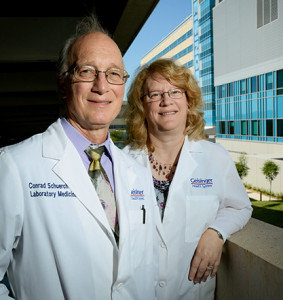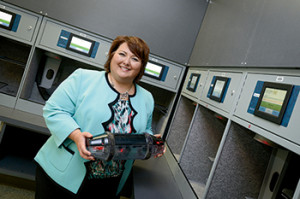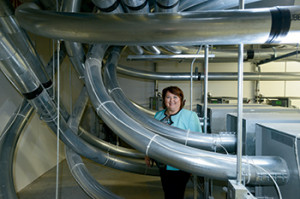Anne Ford
July 2015—The last time Geisinger Medical Laboratories had a new facility, American women were still five years from getting the vote. Typhoid Mary had only recently ceased merrily showering her employers’ food with Salmonella enterica serovar Typhi. And the celebrity name on everyone’s lips was Charlie Chaplin.

A view of the new laboratory building. “I think we have actually achieved the ideal in terms of efficiency,” says Dr. Schuerch (left), with Dr. Wilkerson.
A century later, the Danville, Pa.-based laboratories, which serve the Geisinger Health System and other clients throughout the state, were (at CAP TODAY press time) poised to move into a sparkling-new $63.4 million building—one whose top-of-the-line features make “Star Trek” look like “Sesame Street.”
“This is truly a once-in-a-lifetime opportunity, and it’s going to be a phenomenal showcase for the world to see what lab medicine can do,” says Tammy Germini, operations director for clinical pathology.
Thirty years in the planning, the new building will have a single automated line for chemistry, hematology, immunology, and coagulation; an endlessly reconfigurable floor that also serves as a biohazard and chemical containment system; a tube delivery method that always takes the shortest, fastest route; and a materials management solution that—previous analogy aside—calls to mind nothing so much as Captain Jean-Luc Picard saying “Tea, Earl Grey, hot” to the replicator on “Star Trek: The Next Generation.”
“I think we have actually achieved the ideal in terms of efficiency,” says Conrad Schuerch, MD, chair of laboratory medicine. “This is something that’s been needed for a very long time.”
The laboratories’ previous facilities, in the health system’s original hospital and in a few rented modular buildings, were far from ideal. “It’s 100 years old, and the walls are a foot thick and solid,” says Myra Wilkerson, MD, vice chair for laboratory medicine. “So any time you need to add a new piece of laboratory equipment, it turns into a major construction project. And everything is compartmentalized into little rooms spread over multiple floors and multiple buildings. We’ve grown so large that we have to find closets to put some of our instrumentation and our testing into. Plus it’s very hard to maintain the humidity and temperature control that you need for laboratory instruments to operate well.”

Tammy Germini next to the upgraded pneumatic tube system.
At the section manager level, the situation has been no better. “Everything is in little compartments” far away from each other, says system supervisor for transfusion medicine Michael J. Lopatka, MS, MT(ASCP)SBB. “Let’s say you have to put somebody in a small room to do one test with a 30-minute incubation, but if they leave the room to go do something else while it’s incubating, they might not be able to get back in time for the changeover. Or they might have to gown up to go into that room, then de-gown and come out, just to gown back up again 30 minutes later.”
Such a poor layout is not only a hassle for staff but also a safety issue, Lopatka says. He offers this example: “We currently have one spot where all our samples come in and all of our blood product deliveries come in, and it’s the same spot where products are picked up to go to patients. So the person working in that area is prone to more errors, because they’re trying to deal with incoming specimens, incoming blood products, and issuing blood products to patients.”
Whereas previously the laboratories took up 69,622 fragmented, compartmentalized square feet, the new laboratories will occupy 115,000 square feet over three floors of a four-story building (with the lower level devoted to food service). And the placement of sections within the new building is highly strategic.
“The first floor butts right into our main hospital entrance, so patients coming in can just step to the right, inside a laboratory area for phlebotomy, apheresis, and fine-needle aspiration,” Dr. Schuerch says. “Our patient care services are by the front door of the hospital, our anatomic services are right next to the operating rooms, and our clinical pathology services are on the third floor—but the building is built on the side of a hill, so the couriers can come in at the ground level with our specimens from all over the system.

The floor is raised 18 inches to allow plumbing and electrical and other lines to run beneath it, Dr. Schuerch demonstrates, making architectural modification unnecessary even as the laboratory’s needs change.
“We don’t have an off-site core laboratory, and we don’t have people split up in different places,” he continues. “In addition, we have anatomic pathology and clinical services together, so a pathologist can do all those functions and also not have to walk far for clinical consultations, multidisciplinary tumor conferences, and the like. I can’t imagine designing a laboratory with a better interface with the health system.”
Dr. Wilkerson helped design some of that interface, but her main role in this project has been leading an interdepartmental team charged with selecting an automation line for the new building.
Of course the team wanted the most efficient best-of-breed system possible, but it had another aim too: flexibility. “Once you install one of these large automation lines, you tend to have them in place for at least 10 years,” Dr. Wilkerson notes. “So it was also about durability and whether we would have the option in the future to add other pieces to it. A huge piece of it was also the software that comes with it: Can we get real-time actionable reports out of it? How does it interact with our current LIS?”
In the end, the team chose the Roche 8100 preanalytical line and—in what they believe to be a unique move for a laboratory within the United States—combined it with a Stago coagulation system and a Sysmex hematology system.
“Roche has the chemistry analyzer that we want,” Dr. Wilkerson explains. “But they are also going to hook it up to the coagulation and hematology vendors that we chose. Some of the other vendors were not willing to do that. Also, we liked Roche’s times for immunoassays, in particular their troponins. It’s hugely important for emergency departments to see if a patient is having a myocardial infarction and needs to get to cardiac catheterization. Their turnaround time is only nine minutes, and that’s a really big deal with a stopping heart.”

Dr. Wilkerson in front of the Roche 8000, which is connected by the new Roche 8100 automation line to the Sysmex hematology and Stago coagulation analyzers.
Germini explains how the 8100 will work: “As samples come in, we’ll load them onto the 8100. It will sort them, spin down appropriate specimens in centrifuges, and aliquot when necessary—all within the instrument. It will then take them to the end of the line and put them on a track, and that track will filter them to the different instruments, based on what the LIS says. It will then perform the testing, and at the end of the testing, it will bring the samples back over to the track and take them to a storage unit, which will be attached to the line also, and it will store those samples for a number of days we define.”
Should an add-on order for a sample be received, “we won’t need a human to go into the refrigerator, find the specimens, pull them out, uncap them, put them back on the instrument,” Germini adds. “The system itself will say, ‘OK, I have that,’ pull it out automatically, stick it back on the track, and take it to the instrument that it needs to perform the test. So our efficiency gain from that instrumentation alone is tremendous.”
So tremendous, in fact, that Dr. Schuerch says: “We want to be running everything basically at a stat speed if we can—within an hour or less.”
And if it becomes necessary to reconfigure instruments in the laboratory to achieve that stat speed, they can, thanks to an innovative floor. “The floor is raised 18 inches,” Dr. Schuerch says, “and so we can bring all of the different lines over to our instruments, wherever we want to set them. Plumbing, deionized water, electrical, whatever you want, all can be taken to an instrument at any place. And you can move the instrument without having to change vertical conduits or move walls or anything. We were in our first space for 100 years, and now this is a place where we can be for 100 years without pain, because we can evolve without the expense of architectural modification.”
The flooring system has another advantage, as Dr. Wilkerson points out. “When you’re in a testing area with patient specimens or caustic chemicals and things are spilled on the floor, there’s a seam in the floor, and the fluid won’t move more than 1 millimeter beyond that seam. So it becomes a biohazard and chemical containment system as well.”
The new building will also feature an upgraded pneumatic tube system, one that allows for six- rather than four-inch-diameter tubes and thus is for blood products as well as patient specimens. The new system will rely on a solution from Pevco called Smart Path that, the company says, improves performance by shortening wait times and increasing efficiency and delivery speed.
“Once somebody at a nursing station hits ‘send,’ it’ll be a maximum of three minutes at the first point to get that specimen to the lab,” Dr. Wilkerson says. “There’s a turret where all the pneumatic tubes come together, and it can receive the specimen and then turn it and send it back out a different tube to try to maximize the efficiency of transport.”
Says Germini: “The tube system itself will be able to know the shortest path or the quickest path to get samples to the lab. We expect that the travel time—the time a specimen leaves the floor to the time we receive it in the lab—will be literally cut in half.”

Tammy Germini in the pneumatic tube room that houses the Pevco Smart Path system.
The system also features a secure send function, “so that we can not only send blood products to the floor, but we can make sure it’s received by someone who’s qualified to receive it and in turn give it to the patient,” Germini says. “So we’ll be able to do a lot of tracking.” An accompanying software package will make it possible to see in real time where samples are and where tubes are going. “Maybe the doc says we should have received a specimen, but we say we haven’t gotten it yet. We’ll be able to do that troubleshooting right on the spot,” she says.
One of the new building’s most innovative features is an electronic materials management system called Kardex Remstar. Previously, the laboratory relied on technical specialists to perform inventory about once a week. “So they’ll walk around to their various cubbies or refrigerators. They might have to go down the hall to a closet. Wherever they can fit their supplies,” Germini says. “They’ll do their inventory, they’ll manually put it into a computer system, and then supplies management will process the order. Supplies are brought to the lab in big boxes and our staff then have to open the boxes, receive the supplies, put them on the shelves—the whole process.”
In contrast, the new building contains two Remstar units—one refrigerated, one room temperature—that span all three floors and hold every supply the laboratory might need: gloves, reagents, pipettes, pipette tips, specimen bags, QC material, you name it. Supply chain staff will put supplies away in the Remstar units and restock the workbenches when appropriate.
“An efficiency gained will come from not walking around to all the cubbies, closets, and refrigerators looking for supplies,” Germini says. When supply chain or lab staff go to retrieve supplies, they will walk up to the Remstar unit and enter into the computer the supply number of the item they want. Inside the Remstar unit are carriers mounted to an oval track that rotates vertically, similar to a Ferris wheel. The supplies are stored on these carrier shelves, and the Remstar unit will rotate to the appropriate floor and deliver the supply to the operator.
“It will also place an electronic order based on what we define as the PAR level,” Germini says. “The system will recognize there are five of a particular item left on the shelf and will know to communicate with our supply chain computer system to place an order to replace what’s been removed.”
For his part, Lopatka expects Remstar to be very popular at the bench level. “The techs are going to be able to get out of the supply unpacking business,” he smiles. “They’ll just have all the supplies they need at their fingertips, so they can do what they do for a living.”
Remstar units will be used, too, for specimen storage and tracking. “It will make finding a specimen very easy,” Lopatka says, “since you can look up the specimen in our computer and then tell the Remstar and it will bring the rack to you in a bin.”
He’s also looking forward to simply having a bigger space for blood services—one that’s well laid out from the start: “We’re able to place everything in a way that allows it to flow in one direction, from one end to the other. That also allows people to multitask. They might be the person in charge of the first step, but they can also help engage in the second step to some degree if the person doing the second step is very busy. And then the person from the second step can help with part of the first step. It allows more flexibility. And everybody can see everybody across the whole room, so if somebody needs help, it’s easy to move over and help out.”
Of course, moving the laboratories into the new building won’t be quite as easy as throwing things into boxes and renting a U-Haul. First of all, there’s all the sorting and discarding to be done. “When you’ve been in a space for 100 years, you collect a lot of stuff,” says Germini darkly.
“Magazines. Magazines on top of magazines,” she cites as one example.
But “the biggest piece is, how do you keep 24/7 operations going as you move from one building to the next?” she says. “We are fortunate enough to have a lot of redundancy in our technology. In cases in which we have two instruments, we will take one instrument over, validate it, and bring it back up; then we will bring the second instrument over.”
Considerable as the challenges of moving may be, for Dr. Schuerch the primary obstacle has already been surmounted. “The biggest challenge in getting a new facility is to get your organization behind you,” he says. “It’s taken us 30 years to get there. We’ve had various fits and starts. We were offered a new lab down the road at one point, and we dug in our heels and said, ‘No, the lab needs to be on the main campus.’
“Then later we designed a new lab on campus,” he concludes, “and we went through a couple of iterations there, partly because we had a change in hospital leadership. Then we moved it and re-drew it, and we had Lean consultants in a couple times during all this, and finally, with leadership in agreement, we said, ‘Let’s just get this laboratory building done,’ and moved forward. We had our own staff deeply involved in the planning of this lab. And they’re happy with the outcome.”
[hr]
Anne Ford is a writer in Evanston, Ill.